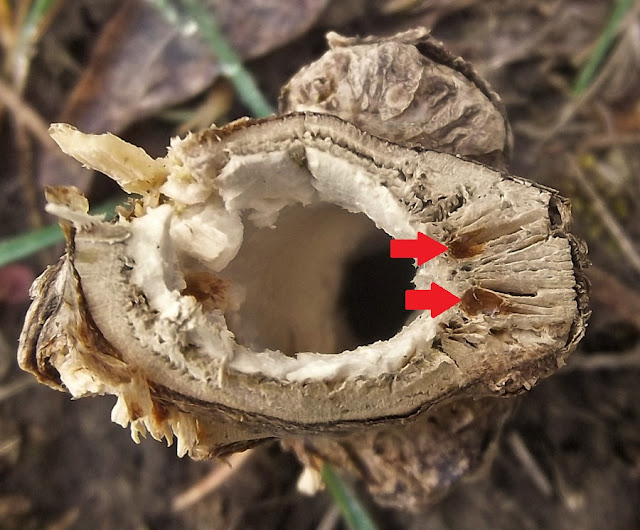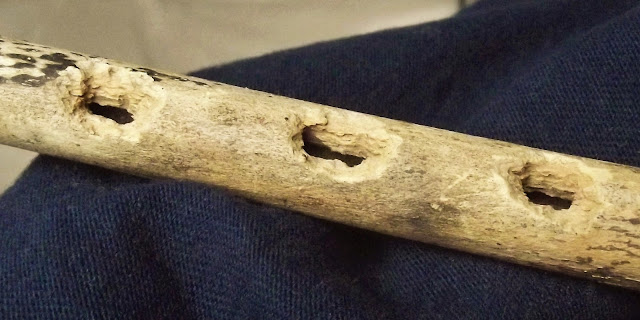A thought inspired by the loveliness of this blue-sky January day:
What I lack is a context for beauty.
What does it mean, that the world is this beautiful?
What do we do, given that the world is this beautiful?
---
In part 1 of this post, we considered a few examples of bird sign on dead wood and on stems of two herbaceous plants, figwort and jewelweed. Here we'll see examples from the stems of two other herbs.
COW PARSNIP
Heracleum maximum is a sort of coarser, jollier, more badass cousin to the ubiquitous wild parsnip (Pastinaca sativa). Cow parsnip and wild parsnip are easier to tell apart during the growing season, but there are obvious differences between their dead stems in the dormant season too. Above, you can see a dead stem of wild parsnip on the left, and one of cow parsnip on the right. Below, fruits: wild parsnip at left, cow parsnip at right.
While visiting some friends early this past summer, I noticed that stems of the cow parsnip growing in their yard had been attacked heavily by some critter trying to get in. It wasn't until many months and two seasons later that I finally returned to Lindy and Lee's in order to document this damage. The plant stems, long since dead and dried, had broken off and fallen to the ground, and some were buried by snow, but I gathered what I could. The attackers' work was still evident.
Now, as with jewelweed, the scientist in me insists on mentioning that I have not directly observed the animal responsible for this. However, based mostly on the form and appearance of the holes, I assert here that a bird is responsible. Someday one of us will catch the culprit in the act!
Unlike jewelweed and figwort, the target insect does not overwinter in the stem. Rather, its stem-dwelling stage -- the larva and pupa -- occurs in the late spring and early summer, when cow parsnip is maturing (and right around the time I first saw damage to these stems at Lindy and Lee's). This insect is the parsnip webworm, Depressaria radiella. Though named, and thus clearly known, for its habit of spinning webs in the flower heads of cow parsnip and wild parsnip, some larvae of the parsnip webworm enter their host plant's stems, which, for cow parsnip at least, are naturally hollow. (Presumably the larvae cut holes in the stems in order to get in and out; this could account for a few of the stem holes evident in the first stem-damage photo above.) Furthermore, some of the larvae will actually pupate inside the stems -- and I suspect it's this pupal stage that the predators were after in the plants at Lindy and Lee's.
Before pupating inside its dark and hollow stem-home, a parsnip webworm larva apparently first etches an oval scrape on the inside of the stem. The larva either eats this excavated material, converting it to frass (caterpillar poop), or simply shaves it off the stem, resulting in an accumulation of sawdust. Either way, it collects the granular byproduct and incorporates it into a domelike cocoon, which it spins over itself just prior to pupating. The results (but with the culprits long gone) are shown below.
First, a piece of stem interior on which four larvae pupated. The most obvious oval scraped areas are on the far left and far right; two more are clustered at center. I've removed the domed cocoons that were spun over three of the scraped areas; the fourth cocoon (at far left) has been flipped over to reveal the scraping underneath it.
Two cocoons, one in the top stem, one in the bottom stem (and part of a third cocoon, I think, at upper right). Larvae scraped the stem underneath these cocoons, processed it into "sawdust" or frass, and finally incorporated it into the cocoons.
Cocoon
Wall of cocoon flipped over, revealing shed skins of larva and pupa, indicating successful emergence of an adult moth
Detail from inside the above cocoon, taken with my "bug scope." After spinning the cocoon (top), the larva sheds its skin (right) to become a pupa. When the adult eventually emerges from the pupa, it leaves the pupal skin behind (left). (And by "skin," I mean exoskeleton.)
Here's a sequence showing another cocoon, its leftover (spent) contents, and the adult that emerged from it:
The adult's wings are improperly formed in this case.
WILD LETTUCE
One winter day, while visiting friends John and Jana, I heard someone a-tap-tap-tapping away in the yard over by the guest cabin. It was unquestionably a woodpecker, but the tapping had a sort of treble quality to it that suggested the bird was tapping on something other than wood. Walking over to investigate, I frightened a downy woodpecker from a dead stem of a tall, weedy herb. The stem belonged to a wild lettuce, Lactuca biennis. Here's a different stem of the same plant species, also from John and Jana's, with the author attempting to provide scale but mainly just looking like a super dork. As you can see, this herb gets to be quite tall!
Seedhead of Lactuca biennis, with most of the seeds already gone
Well, when I got close to examine the downy woodpecker's wild lettuce stem, I was astonished and delighted at what I found. A significant portion of the plant stem had been stripped or pecked away. (I stripped away more as I investigated, then took the photo below.) This activity had exposed the pale inner pith of the hollow stem, and this exposed pith, all up and down the stem, had been thoroughly pecked over by birds. Below, the whole dead stem is shown (at left), along with two details of affected portions (at right).
Here's a detail of an affected area near the base of the stem:
At first, I thought all those brown specks were simply peck marks left by birds. As I looked closer, I noted that the birds had indeed excavated the pith in these areas. But their pecking hadn't caused the brown specks. In fact, the "specks" were little round chambers in the pith, hundreds of them, each one emptied by the birds of whatever had been inside it.
To illustrate what I mean, here's another dead stem of a wild lettuce plant attacked by hungry birds. I found this one on a property in Clayton County, IA where friends Joe, Conor, and I spent some time last year.
As they peck and probe the pith, the birds' bills leave small indentations (labeled, at center of inset). However, this sign is quite distinct from the brown "specks" -- more clearly identifiable here as chambers (see label at upper right of inset) -- that are constructed in the pith by the insect that the birds are harvesting. As it turns out, before it gets raided by a bird, each of these little brownish chambers contains a single cream-colored insect larva:
This is the larva of a tiny, black, non-stinging wasp in the family Cynipidae. Animals of this kind are known as "gall wasps" for their habit of growing to maturity inside the swellings they induce in plant tissue. Not all plants affected by gall wasps show obvious swelling; this one didn't. However, the tattered wild lettuce stem at John and Jana's did have some galls on one spot along its length:
The birds, of course, noticed.
A cross-section of the swollen stem reveals two gall wasp chambers (arrrows). I think the larvae fell out when I cut the stem open, which is why they aren't visible here.
Another gall on the stem, sectioned, showing larvae in their chambers
At the time, I didn't know exactly what this insect was, so I collected a few pieces of affected stem from John and Jana's and put them in a jar. That was early April; by late May, adult gall wasps in the genus Aulacidea had begun to emerge.
---
A final note: When I came across this bird-insect-plant association, it wasn't just the insect I couldn't identify; I wasn't quite sure about the plant, either. As you might expect, identifying plants by their dead stems can be challenging. However, it's been so useful to me as an amateur entomologist that I have spent the last few dormant seasons learning to do it, and it's not only possible, but also satisfying and enlightening. Along the way I've picked up a trick or two. One of these involves the leaves.
Though many flowering plants shed their leaves in fall, some leaves stay attached, especially on certain herbaceous plants, where they simply shrivel up and hang from the stems. If the dead stem of a mystery herb has any such leaves still hanging on, try collecting a few of them (carefully, as they are quite fragile) and placing them in a shallow, flat-bottomed container of water. The shriveled leaves will gradually rehydrate, and once they're waterlogged, you can (carefully) use a toothpick or other tool to gently pull them open and flatten them out (while they're still in the water, ideally). This will reveal the general shape, veination, and other details of the leaf useful for making an identification.
I tried this rehydrated leaf method with a few leaves from the then-mystery plant occupied by the then-mystery insect at John and Jana's. Here's the result:
Compare with the image here of a living leaf of Lactuca biennis. It takes a bit of effort and patience, but this method works!


















































